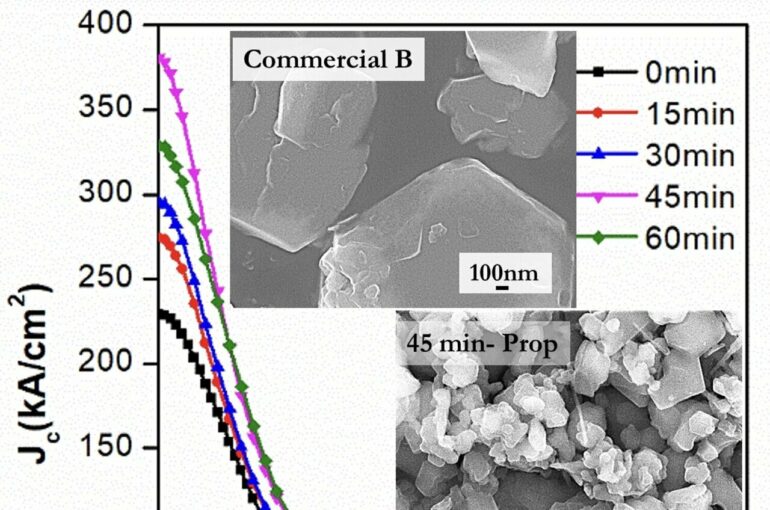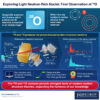Magnesium diboride (MgB2) is a low-cost, non-toxic superconductor used in field magnets, electric motors, and generators. However, producing nanoscale boron (B) particles to fabricate MgB2 is expensive. Researchers recently tackled this issue by using high-energy ultra-sonication in 2-propanol, a highly viscous solvent, to produce impurity-free, nm-sized B particles. The approach is cost-effective and enables fabrication of bulk MgB2 with high critical current density, a prerequisite for the sustainable production of high-performance superconducting magnets.
Magnesium diboride (MgB2), a binary compound, behaves as a superconductor—a substance that offers no resistance to electric current flowing through it—at a moderate temperature of around 39 K (-234°C). This temperature can be achieved using relatively inexpensive liquid hydrogen or neon coolants.
In addition, MgB2 is inexpensive, lightweight, and non-toxic, and its precursors—magnesium (Mg) and boron (B)—are abundantly available. As a result, it can replace conventional low-temperature superconductors that require expensive liquid helium for cooling and substitute magnets based on neodymium, a rare element, as well as iron and boron.
MgB2 finds a wide range of applications, including the manufacture of coils and magnets for magnetic resonance imaging, nuclear magnetic resonance, magnetic drug delivery, fault current limiters, electric motors, and transportation. According to research, MgB2 is a good candidate for polycrystalline superconducting magnets as it exhibits good critical current density (Jc) and a high trapped magnetic field (TF).
It, however, suffers from weak magnetic flux pinning. To enhance pinning, it is essential to tune the pinning centers in MgB2—the boundaries of grains or small crystals that constitute MgB2. To this end, researchers have now shown how nano-sized B particles can be used as B precursors to fabricate nano-sized MgB2 grains with strong grain boundary pinning and high Jc.
Currently, B nanoparticles are produced by ball milling, pyrolysis, and sintering. These techniques, however, suffer from drawbacks such as low purity output and poor cost-effectivity, necessitating better alternatives. To this end, a group of scientists led by Prof. Muralidhar Miryala from Shibaura Institute of Technology (SIT), Japan recently explored high-energy ultra-sonication as a cost-effective alternative for refining coarse B powder dispersed in 2-propanol up to nanoscale sizes. Their work was made available in the Journal of Alloys and Compounds.
“In this technique, ultrasonic vibrations impart high speeds to B particles in the solvent, leading to collisions. The resulting friction and shear tearing, compression, and energy release by the collapse of tiny air bubbles produced during collision break down B particles to nanometer sizes,” explains Prof. Miryala.
Using 2-propanol as the solvent for B, the researchers ultrasonically refined cheap commercial B powder for 45 minutes to produce oxide-free nm-sized B particles. They then utilized them to fabricate bulk MgB2 with scarce oxide and no carbon impurities, which showed superconductivity at around 38.5 K.
Furthermore, it showed high Jc values of 500 and 380 kA cm-2 at 10 K and 20 K, respectively. The latter of these Jcvalues marked an 80% improvement compared to that for bulk MgB2 prepared from cheap B powder and was at par with that for expensive commercial B powder. The observed increase in Jc was due to better grain boundary pinning in MgB2 as revealed by microstructural analysis, and theoretically supported by the Dew–Hughes theory.
Finally, the researchers performed field cooling magnetization simulations, predicting that a 40-mm wide and 10 mm-thick MgB2 disk prepared from ultrasonically refined B powder can exhibit a high TF of 2.5 teslas. “These findings bring MgB2 superconducting magnets, which can be fabricated in the form of tapes, wires, and films, a step closer to their commercialization,” says Prof. Miryala.
More information:
A. Sai Srikanth et al, Tuning of grain boundaries in MgB2 by boron ultra-sonication in 2-propanol—A way to low-cost high-J bulk superconducting magnets, Journal of Alloys and Compounds (2023). DOI: 10.1016/j.jallcom.2023.170146
Provided by
Shibaura Institute of Technology
Citation:
Towards a sustainable superconductor technology with magnesium diboride super magnets (2023, May 1)



